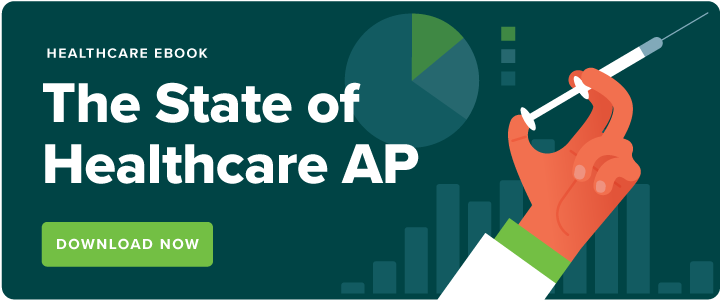As healthcare providers in 2020 desperately searched for N-95 masks, ventilators, and other medical equipment, it became all-too-apparent just how critical supplier relationships are to these organizations. While the scarcity was caused by many factors, including off-shore production, shuttered factories during COVID-19 quarantines, and low stockpiles, it nonetheless exposed just how dependent healthcare providers are on their suppliers.

While many factors contribute to maintaining and improving supplier relationships, one that’s often overlooked by healthcare organizations is vendor payments. Let’s face it: your suppliers want to be paid on time and many depend on a healthy cash flow to buy the raw materials they need to produce and keep equipment, devices, and other products flowing to healthcare organizations like yours.
Paying suppliers on time can go a long way in providing the cash flow they need and boosting supplier relationships. Unfortunately, it has not been easy for many healthcare organizations to consistently make on-time vendor payments. That’s because too many providers still rely on manual, paper-based Accounts Payable processes, which often lead to problems, delays, and overdue payments.
6 Manual AP Processes That Can Lead to Late Vendor Payments
Here are the areas where the process often gets hung up:
- Manual invoice receipt. It’s not unusual for invoices in healthcare organizations to be sent to multiple people in different locations. The AP team may not be aware these have arrived and locating the hundreds or thousands of invoices that arrive each month can be like herding cats. This often results in lost or misplaced invoices, delays, and late payments. The remedy: Create a centralized place where all invoices will be received, ideally an email distribution list that’s accessible by the AP team.
- Manual invoice capture. Healthcare invoices can be pages long with multiple lines of medical supplies that AP clerks need to manually enter into the accounting system. It’s a costly and very time-consuming process, slowing down the entire AP process and opening up the opportunity for errors, which only adds to the delays. The remedy: An AP automation solution will automate invoice capture for you, allowing you to quickly extract header and line-level information with a high degree of accuracy.
- Manual invoice approval – Numerous doctors, nurses, and other healthcare professionals across the healthcare facility need to approve items on the invoices. Manually routing them around the hospital or facility—whether physically or via email—is a waste of time, both for AP and for the reviewers, who are busy focusing on patient care. This process can take weeks and invoices can easily fall through the cracks. The remedy: By digitizing AP, you can automate the invoice approval workflow as well, making it fast, efficient, and painless. No more chasing approvers via email!
- Manual payment authorization. Once the invoices have been approved, the AP manager needs to determine which ones to pay in the next payment run and then route them to the CFO or controller for authorization. If the authorizer is unavailable or away, this could add to payment delays. The remedy: Automated payment handles the routing and authorization process, allowing designated payment authorizers to validate the payment run anytime, anywhere. This helps ensure that payments are not overlooked or forgotten, and due dates are not missed.
- Manual payment execution. Unfortunately, 80% of payments made by healthcare organizations are paper checks. Not only is this costly – when you factor in the paper, ink, and staff time, it costs about $5 per check to issue – but it’s also incredibly time-consuming. In addition to the time it takes to prepare the check, and get it signed, you also have to account for delivery. There’s a reason that “The check’s in the mail” has been such a readily available excuse because everyone knows it can take a week or so for something to arrive. The remedy: Automate the payments process to get money to your suppliers quickly and efficiently. It enables providers to precisely time payments to hold onto cash as long as possible, while still paying suppliers within their terms.
- Manual Reporting & Analysis. It is a monumental task to consolidate and analyze data across invoices, payments, and vendors at any given time. AP teams that do not have a handle on invoice aging, days outstanding, or vendor utilization will run the risk of disrupting supplier relationships or losing favorable invoice terms. For healthcare companies that rely on their vendors for specialized equipment or R&D supplies, this can be a huge downside. The remedy: Implement an AP automation solution that also automates the reporting and analysis of AP data at all stages, from incoming invoices to outgoing payments. This enables real-time visibility into accounts payable KPIs at all times, so finance leaders can make timely, data-driven decisions.
Payment Automation Benefits Healthcare Organizations and Their Suppliers
When it comes to traditional means of payment, healthcare providers and their suppliers are on opposite sides of the process. While organizations want to extend days payable outstanding (DPO), suppliers want to be paid as soon as possible. By paying faster, we can make sure that you are not exceeding the credit limits that you’ve established with suppliers and avoid any hold-ups in receiving essential medical supplies and other items. Consistently making on-time vendor payments also gives you leverage to negotiate and extend these credit limits.
Another benefit of payments automation is that you have multiple payment methods to choose from to meet both of your needs. For example, virtual cards or v-cards, enable you to pay suppliers immediately, while giving you the benefit of cash-back rebates.
The relationship between healthcare organizations and their suppliers is interdependent and more important than ever. Suppliers are relying on you for prompt payment and steady cash flow so they can keep producing supplies, and in turn, get them to you when you need them. AP automation will help with this process, keeping vendor payments moving and on time, making suppliers happier, and providing you with greater efficiencies and cost-efficiencies.



